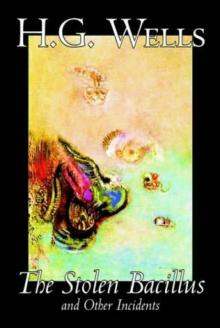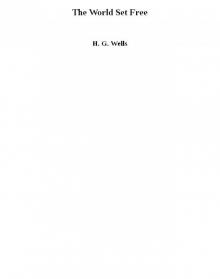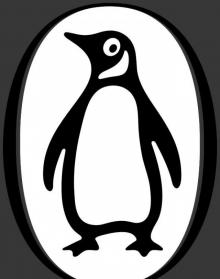- Home
- H. G. Wells
Island of Dr. Moreau Page 3
Island of Dr. Moreau Read online
Page 3
But in Christianity, God is a Trinity, and on Moreau’s island there are three beings whose names begin with M. Moreau as a name combines the syllable ‘mor’ – from mors, mortis, no doubt – with the French for ‘water’, suitable in one who aims at exploring the limits of plasticity. The whole word means ‘Moor’ in French. So the very white Moreau is also the Black Man of witchcraft tales, a sort of anti-God.
Montgomery, his alcoholic assistant, has the face of a sheep. He acts as the intercessor between the Beast Folk and Moreau, and in this function stands in for Christ the Son. He’s first seen offering Prendick a red drink that tastes like blood and some boiled mutton. Is there a hint of an ironic Communion Service here – blood drink, flesh of the Lamb? The communion Prendick enters into by drinking the red drink is the communion of carnivores, that human communion forbidden to the Beast Folk. But it’s a communion he was part of anyway.
The third person of the Trinity is the Holy Spirit, usually portrayed as a dove – God in living but non-human form. The third M-creature on the island is M’Ling, the beast-creature who serves as Montgomery’s attendant. He too enters into the communion of blood: he licks his fingers while preparing a rabbit for the human beings to eat. The Holy Spirit as a deformed and idiotic man-animal? As a piece of youthful blasphemy, The Island of Doctor Moreau was even more blasphemous than most commentators have realized.
Just so we don’t miss it, Wells puts a serpent-beast into his dubious garden: a creature that was completely evil and very strong, and that bent a gun-barrel into the letter S. Can Satan, too, be created by man? If so, blasphemous indeed.
7. The New Woman as Catwoman
There are no female human beings on Moreau’s island, but Moreau is busily making one. The experiment on which he’s engaged for most of the book concerns his attempt to turn a female puma into the semblance of a woman.
Wells was more than interested in members of the cat family, as Brian Aldiss pointed out in his introduction to the 1993 Everyman edition of the novel. During his affair with Rebecca West, she was ‘Panther’, he was ‘Jaguar’. But ‘cat’ has another connotation: in slang, it meant ‘prostitute’. This is Montgomery’s allusion when he says – while the puma is yelling under the knife – ‘I’m damned… if this place is not as bad as Gower Steet – with its cats’. Prendick himself makes the connection explicit on his return to London when he shies away from the ‘prowling women (who) would mew after me’.
‘I have worked hard at her head and brain,’ says Moreau of the puma, ‘… I will make a rational creature of my own’. But the puma resists. She’s almost a woman – she weeps like one – but when Moreau begins torturing her again, she utters a ‘shriek almost exactly like that of an angry virago’. Then she tears her fetter out of the wall and runs away, a great bleeding scarred suffering female monster. It is she who kills Moreau.
Like many men of his time, Wells was obsessed with the New Woman. On the surface of it he was all in favour of sexual emancipation, including free love, but the freeing of Woman evidently had its frightening aspects. Rider Haggard’s She can be seen as a reaction to the feminist movement of his day – if women are granted power, men are doomed – and so can Wells’s deformed puma. Once the powerful monstrous sexual cat tears her fetter out of the wall and gets loose, minus the improved brain she ought to have courtesy of Man the Scientist, look out.
8. The Whiteness of Moreau, the Blackness of M’Ling
Wells was not the only nineteenth-century English writer who used furry creatures to act out English socio-dramas. Lewis Carroll had done it in a whimsical way in the Alice books, Kipling in a more militaristic fashion in The Jungle Books.
Kipling made the Law sound kind of noble, in The Jungle Books. Not so Wells. The Law mumbled by the animal-men in Moreau is a horrible parody of Christian and Jewish liturgy; it vanishes completely when the language of the beasts dissolves, indicating that it was a product of language, not some eternal God-given creed.
Wells was writing at a time when the British Empire still held sway but the cracks were already beginning to show. Moreau’s island is a little colonial enclave of the most hellish sort. It’s no accident that most (although not all) of the Beast Folk are black or brown, that they are at first thought by Prendick to be ‘savages’ or ‘natives’, and that they speak in a kind of mangled English. They are employed as servants and slaves, a regime that’s kept in place with whip and gun; they secretly hate the real ‘men’ as much as they fear them, and they disobey the Law as much as possible and kick over the traces as soon as they can. They kill Moreau and they kill Montgomery and they kill M’Ling, and, unless Prendick can get away, they will kill him too, although at first he ‘goes native’ and lives among them, and does things that fill him with disgust, and that he would rather not mention.
White man’s burden, indeed.
9. The Modern Ancient Mariner
The way in which Prendick escapes from the island is noteworthy. He sees a small boat with a sail and lights a fire to hail it. It approaches, though strangely it doesn’t sail with the wind, but yaws and veers. There are two figures in it, one with red hair. As the boat enters the bay, ‘Suddenly a great white bird flew up out of the boat, and neither of the men stirred. It circled round, and then came sweeping overhead with its strong wings outspread’. This bird cannot be a gull: it’s too big and solitary. The only white seabird usually described as ‘great’ is the albatross.
The two figures in the boat are dead. But it is this death-boat, this life-in-death coffin-boat, that proves the salvation of Prendick.
In what other work of English literature do we find a lone man reduced to a pitiable state, a boat that sails without a wind, two death-figures, one with unusual hair, and a great white bird? The work is of course ‘The Rime of the Ancient Mariner’, which revolves around man’s proper relation to Nature, and concludes that this proper relation is one of love. It is when he manages to bless the sea-serpents that the Mariner is freed from the curse he has brought upon himself by shooting the albatross.
The Island of Doctor Moreau also revolves around man’s proper relation to Nature, but its conclusions are quite different, because Nature itself is seen differently. It is no longer the Nature eulogized by Wordsworth, that benevolent motherly entity who never did betray that heart that loved her, for between Coleridge and Wells came Darwin.
The lesson learned by the albatross-shooting Mariner is summed up by him at the end of the poem:
He prayeth well, who loveth well
Both man and bird and beast.
He prayeth best, who loveth best
All things both great and small;
For the dear God who loveth us,
He made and loveth all.
In the Ancient-Mariner-like pattern at the end of The Island of Doctor Moreau, the ‘albatross’ is still alive. It has suffered no harm at the hands of Prendick. But he lives in the shadow of a curse anyway. His curse is that he can’t love or bless anything living: not bird, not beast, and most certainly not man. He is weighed down by another curse, too: the Ancient Mariner is doomed to tell his tale, and those who hear it are convinced by it. But Prendick chooses not to tell, because, when he tries, no one will believe him.
10. Fear and Trembling
What then is the lesson learned by the unfortunate Prendick? It can perhaps best be understood in reference to The Ancient Mariner. The God of Moreau’s island can scarcely be described as a dear God who makes and loves all creatures. If Moreau is seen to stand for a version of God the Creator who ‘makes’ living things, he has done – in Prendick’s final view – a very bad job. Similarly, if God can be considered as a sort of Moreau, and if the equation ‘Moreau is to his animals as God is to man’ may stand, then God himself is accused of cruelty and indifference – making man for fun and to satisfy his own curiosity and pride, laying laws on him he cannot understand or obey, then abandoning him to a life of torment.
Prendick cannot love the distorted a
nd violent furry folk on the island, and it’s just as hard for him to love the human beings he encounters on his return to ‘civilization’. Like Swift’s Gulliver, he can barely stand the sight of his fellow-men. He lives in a state of queasy fear, inspired by his continued experience of dissolving boundaries: as the beasts on the island have at times appeared human, the human beings he encounters in England appear bestial. He displays his modernity by going to a ‘mental specialist’, but this provides only a partial remedy. He feels himself to be ‘an animal tormented… sent to wander alone…’.
Prendick forsakes his earlier dabblings in biology, and turns instead to chemistry and astronomy. He finds ‘hope’ – ‘a sense of infinite peace and protection in the glittering hosts of heaven’. As if to squash even this faint hope, Wells almost immediately wrote The War of the Worlds, in which not peace and protection, but malice and destruction, come down from the heavens in the form of the monstrous but superior Martians.
The War of the Worlds can be read as a further gloss on Darwin. Is this where evolution will lead – to the abandonment of the body, to giant sexless bloodsucking heads with huge brains and tentacle-like fingers? But it can also be read as a thoroughly chilling coda to The Island of Doctor Moreau.
Margaret Atwood
NOTE
1. The ‘brass brassière’ is from an oral history of science fiction prepared by Richard Wolinsky for the radio station KPFA-FM in Berkeley, California.
Further Reading
The most vivid and memorable account of Wells’s life and times is his own Experiment in Autobiography (2 vols., London: Gollancz and Cresset Press, 1934). It has been reprinted several times. A ‘postscript’ containing the previously suppressed narrative of his sexual liaisons was published as H. G. Wells in Love, edited by his son G. P. Wells (London: Faber & Faber, 1984). His more recent biographers draw on this material, as well as on the large body of letters and personal papers archived at the University of Illinois and elsewhere. The fullest and most scholarly biographies are The Time Traveller by Norman and Jeanne Mackenzie (2nd edn, London: Hogarth Press, 1987) and H. G. Wells: Desperately Mortal by David C. Smith (New Haven and London: Yale University Press, 1986). Smith has also edited a generous selection of Wells’s Correspondence (4 vols., London: Pickering & Chatto, 1998). Another highly readable, if controversial and idiosyncratic, biography is H. G. Wells: Aspects of a Life (London: Hutchinson, 1984) by Wells’s son Anthony West. Michael Foot’s H. G.: The History of Mr Wells (London and New York: Doubleday, 1995) is enlivened by its author’s personal knowledge of Wells and his circle.
Two illuminating general interpretations of Wells and his writings are Michael Draper’s H. G. Wells (Basingstoke: Macmillan, 1987) and Brian Murray’s H. G. Wells (New York: Continuum, 1990). Both are introductory in scope, but Draper’s approach is critical and philosophical, while Murray packs a remarkable amount of biographical and historical detail into a short space. John Hammond’s An H. G. Wells Companion (London and Basingstoke: Macmillan, 1979) and H. G. Wells (Harlow and London: Longman, 2001) combine criticism with useful contextual material. H. G. Wells: The Critical Heritage, edited by Patrick Parrinder (London: Routledge, 1972), is a collection of reviews and essays of Wells published during his lifetime. A number of specialized critical and scholarly studies of Wells concentrate on his scientific romances. These include Bernard Bergonzi’s pioneering study of The Early H. G. Wells (Manchester: Manchester University Press, 1961); John Huntington, The Logic of Fantasy: H. G. Wells and Science Fiction (New York: Columbia University Press, 1982); and Patrick Parrinder, Shadows of the Future: H. G. Wells, Science Fiction and Prophecy (Liverpool: Liverpool University Press, 1995). Peter Kemp’s H. G. Wells and the Culminating Ape (London and Basingstoke: Macmillan, 1982) offers a lively and, attimes, lurid tracing of Wells’s ‘biological themes and imaginative obsessions’, while Roslynn D. Haynes’s H. G. Wells: Discoverer of the Future (London and Basingstoke: Macmillan, 1980) surveys his use of scientific ideas. W. Warren Wagar, H. G. Wells and the World State (New Haven: Yale University Press, 1961) and John S. Partington, Building Cosmopolis (Aldershot: Ashgate, 2003) are studies of his political thought and his schemes for world government. John S. Partington has also edited The Wellsian (The Netherlands: Equilibris, 2003), a selection of essays from the H. G. Wells Society’s annual critical journal of the same name. The American branch of the Wells Society maintains a highly informative website at http://hgwellsusa.50megs.com
P.P.
Note on the Text
H. G. Wells began writing The Island of Doctor Moreau in January 1895, immediately after finishing The Time Machine. By April of that year he had placed an early version of the story in the hands of his agent, A. P. Watt. The book was completed in June, but negotiations over its publication were protracted and, unusually for Wells, no magazine serialization was forthcoming. The first London edition was published by William Heinemann in April 1896, while the New York edition, subtitled ‘A Possibility’, appeared from Stone and Kimball in August. In a ‘Note’ at the end of both texts Wells draws attention to a Saturday Review article (‘the Limits of Individual Plasticity’, 19 January 1895) where he had set out the substance of Dr Moreau’s explanation in Chapter 14. The ‘Note’ adds that:
Strange as it may seem to the unscientific reader, there can be no denying that, whatever amount of credibility attaches to the detail of this story, the manufacture of monsters – and perhaps even of quasi-human monsters – is within the possibilities of vivisection.
Wells made extensive stylistic revisions to The Island of Doctor Moreau for the benefit of its French translator, Henry-D. Davray, whose version appeared in three instalments in the Mercure de France (December 1900–February 1901). Some, though by no means all, of these revisions were incorporated into a revised edition published by Heinemann in 1913, which Wells later used as the basis for the text included in Volume II of the Atlantic Edition of the Works of H. G. Wells (London: T. Fisher Unwin, and New York: Scribner’s, 1924). The Atlantic text was intended to be definitive, but the 1913 Heinemann edition on which it was based is, unfortunately, unreliable at a number of points. In addition, Wells continued to allow earlier versions of the text to be reprinted during his lifetime. The latest of these reprints was the 1946 Penguin edition, which contains two crucial corrections not found in any earlier version. It follows that a composite text of The Island of Doctor Moreau will best serve the needs of twenty-first-century readers.
The present edition therefore follows the Atlantic text, modified as set out below. The most difficult decision for an editor of The Island of Doctor Moreau concerns the Introduction (with a consequent footnote in Chapter 15), supposedly by Edward Prendick’s nephew. The Introduction was included in the London and New York first editions but omitted from the 1913 Heinemann and the Atlantic. It then reappeared in the 1946 Penguin edition, which was prepared during Wells’s lifetime though actually published a few weeks after his death. The 1946 version corrects a blatant error in the 1896 editions, changing the longitude of ‘105º E’ to ‘105º W’ and thus placing Edward Prendick’s disappearance in the Pacific Ocean (and close to the Galapagos Islands). All recent editions of The Island of Doctor Moreau have included the Introduction, sometimes printing it as an Appendix. In the present edition I have followed the precedent of previous Penguin editions by restoring it to the main text and retaining the footnote. The textual source for the Introduction is the 1946 Penguin.
In the Introduction (6:5), Stone and Kimball 1896 and Penguin 1946 read ‘Africa’, which is apparently a misreading of Heinemann 1896’s ‘Arica’ (a port in Chile). Apart from the restoration of the Introduction and the footnote in Chapter 15, the substantive emendations to the Atlantic text in the present edition are listed below. In addition, the hyphens have been removed from about a dozen words, including blood-stained, gun-boat, half-way, to-morrow and to-night, in accordance with modern practice. ‘Any one’ has been changed to ‘anyone’, ‘every one’ to ‘e
veryone’, ‘some one’ to ‘someone’ and ‘leaped’ to ‘leapt’ where appropriate. Half a dozen commas found in Heinemann 1913 have been restored for the sake of clarity, and two new paragraphs made (27:10, 78:14). The following spellings have been modernized: ‘dinghy’ for ‘dingey’, ‘coconut’ for ‘cocoanut’, ‘faggots’ for ‘fagots’, ‘hyena’ for ‘hyæna’.
Housestyling of punctuation and spelling has also been implemented to make the text more accessible to the reader: single quotation marks (for doubles) with doubles inside singles as needed; end punctuation placed outside end quotation marks when appropriate; spaced N-dashes (for the heavier, longer M-dash) and M-dashes (for double-length 2M-dash); ‘iz’ spellings (e.g. recognize, not recognise), and acknowledgements and judgement, not acknowledgments and judgment; no full stop after personal titles (Dr, Mr, Mrs) or chapter titles, which may not follow the capitalization of the copy-text.
SOURCES OF SUBSTANTIVE EMENDATIONS
The list specifies the earliest text containing each reading, using the following abbreviations: A = Atlantic, H 1 = Heinemann 1896, H 2 = Heinemann 1913, P = Penguin, S = Stone and Kimball.
Page/line
Reading adopted
Atlantic reading rejected
7:23
breaker (H 1)
breaker (H 2)
42:13
raising (H 1)
rising (H 2)
44:17
level place (H 1)
level (H 2)
59:6
or (H 2)
of (A)

 Ann Veronica: A Modern Love Story
Ann Veronica: A Modern Love Story The Time Machine
The Time Machine The First Men in the Moon
The First Men in the Moon The Stolen Bacillus and Other Incidents
The Stolen Bacillus and Other Incidents The War of the Worlds
The War of the Worlds The Invisible Man: A Grotesque Romance
The Invisible Man: A Grotesque Romance The Island of Doctor Moreau
The Island of Doctor Moreau The Door in the Wall, and Other Stories
The Door in the Wall, and Other Stories The Best Science Fiction Stories of H G Wells
The Best Science Fiction Stories of H G Wells The Sea Lady
The Sea Lady The Wonderful Visit
The Wonderful Visit Love and Mr. Lewisham
Love and Mr. Lewisham Marriage
Marriage Tales of Space and Time
Tales of Space and Time The War of the Worlds (Penguin Classics)
The War of the Worlds (Penguin Classics) Twelve Stories and a Dream
Twelve Stories and a Dream The Food of the Gods and How It Came to Earth
The Food of the Gods and How It Came to Earth Tono-Bungay
Tono-Bungay The War in the Air
The War in the Air The Sleeper Awakes
The Sleeper Awakes The Country of the Blind and Other Stories
The Country of the Blind and Other Stories Kipps
Kipps The World Set Free
The World Set Free The Country of the Blind and other Selected Stories
The Country of the Blind and other Selected Stories Ann Veronica
Ann Veronica Ann Veronica a Modern Love Story
Ann Veronica a Modern Love Story The Time Machine and The War of the Worlds
The Time Machine and The War of the Worlds Time Machine and The Invisible Man (Barnes & Noble Classics Series)
Time Machine and The Invisible Man (Barnes & Noble Classics Series) The Time Machine and The Invisible Man
The Time Machine and The Invisible Man The Island of Dr. Moreau
The Island of Dr. Moreau Selected Stories of H. G. Wells
Selected Stories of H. G. Wells Island of Dr. Moreau
Island of Dr. Moreau THE NEW MACHIAVELLI
THE NEW MACHIAVELLI